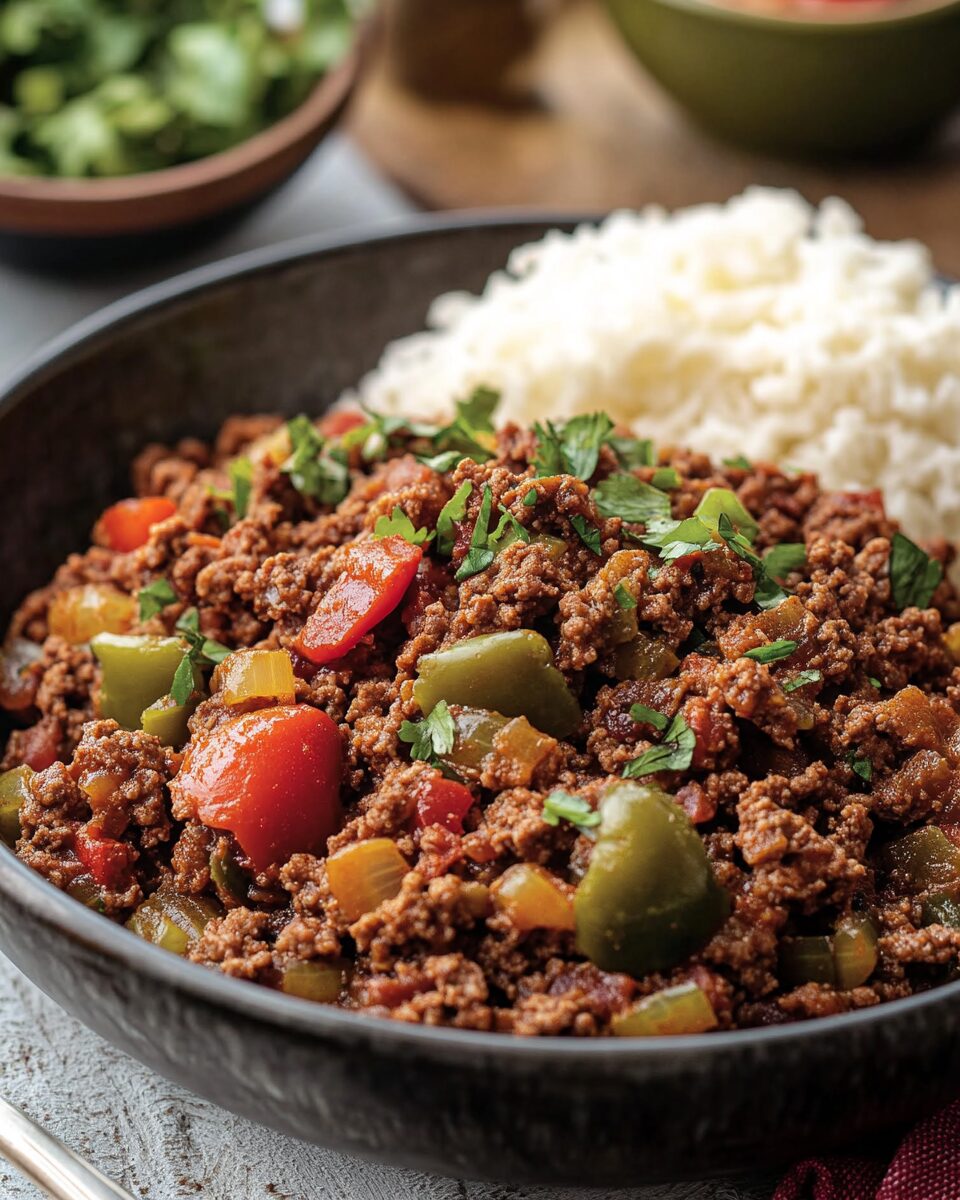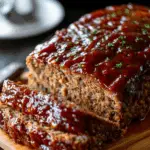The vibrant taste of Cuba comes alive in this traditional dish of Cuban Beef Picadillo. This recipe strikes a beautiful balance of sweet and savory, with juicy ground beef simmered in a tomato-based sauce, brimming with olives and raisins for an unforgettable depth of flavor.
It’s a one-pan wonder perfect for busy weeknights or when you’re craving something comforting yet different. Served over fluffy white rice or alongside fried plantains, this dish brings warmth, nostalgia, and a taste of Latin culture straight to your table. Every bite tells a story of heritage, flavor, and home-cooked love.
Full Recipe
Ingredients:
-
1 tbsp olive oil
-
1 medium onion, finely chopped
-
1 green bell pepper, finely chopped
-
3 cloves garlic, minced
-
1½ lbs ground beef (80/20)
-
1 tsp ground cumin
-
1 tsp dried oregano
-
½ tsp ground cinnamon
-
¼ tsp ground cloves
-
1 bay leaf
-
2 tbsp tomato paste
-
1 (8 oz) can tomato sauce
-
½ cup dry white wine (optional)
-
¼ cup water (or beef broth)
-
⅓ cup green olives, sliced
-
⅓ cup raisins
-
Salt and pepper, to taste
Directions:
-
Heat olive oil in a large skillet over medium heat. Add the chopped onion and bell pepper. Cook for about 5 minutes, until softened.
-
Add minced garlic and cook for another minute until fragrant.
-
Add the ground beef, breaking it apart with a spoon. Cook until browned and no longer pink.
-
Stir in cumin, oregano, cinnamon, cloves, bay leaf, and tomato paste. Cook for 1-2 minutes to allow the spices to bloom.
-
Add tomato sauce, white wine (if using), and water. Stir to combine and bring to a gentle simmer.
-
Reduce heat to low and add the olives and raisins. Cover partially and simmer for 15-20 minutes, stirring occasionally.
-
Season with salt and pepper to taste. Remove bay leaf before serving.
-
Serve hot over white rice or with fried plantains on the side.
Prep Time: 10 minutes | Cooking Time: 30 minutes | Total Time: 40 minutes
Kcal: 365 kcal | Servings: 6 servings
What is Cuban Picadillo?
Cuban Picadillo is one of the most iconic and beloved comfort foods in Cuban cuisine. The word picadillo comes from the Spanish verb picar, meaning “to mince” or “to chop,” and the dish itself features finely ground or minced beef cooked with a distinctive combination of savory and sweet ingredients. While picadillo is popular across Latin America and even the Philippines, the Cuban version is especially unique for its use of green olives and raisins—creating a complex balance of flavors that’s both rich and intriguing.
The core of Cuban Picadillo is its cultural duality. It is a rustic, humble dish born from home kitchens, yet it showcases the global influences that have shaped Cuban food: Spanish spices, African sweetness, and Caribbean boldness. It’s more than a recipe—it’s a culinary story passed down through generations.
The History and Cultural Importance of Picadillo
Picadillo has its roots in Spanish colonial cooking, where ground meat dishes were common due to their affordability and versatility. As Spaniards colonized the Caribbean, they brought their culinary traditions with them. Over time, local ingredients like tropical fruits, peppers, and spices were incorporated into these old-world recipes, giving rise to region-specific adaptations like Cuban Picadillo.
In Cuba, picadillo became a staple in both everyday meals and celebratory occasions. It is a common dish served in Cuban homes and is even part of traditional school lunches. For many Cuban families, picadillo is a taste of childhood, a reminder of family dinners and the heart of home cooking.
What makes it particularly distinct in Cuba is the addition of green olives and raisins. This combination is not only bold but symbolic—a merging of sweet and salty, representing the island’s cultural melting pot. Some versions even include potatoes, capers, or a splash of wine, each bringing a layer of richness and complexity.
Why Cuban Picadillo Stands Out
Cuban Picadillo is often praised for its balanced flavor profile. The briny green olives cut through the richness of the ground beef, while the raisins add little bursts of sweetness. This harmony of flavors mirrors the balance in many traditional Cuban dishes, where seasoning is bold but not overpowering, and ingredients are layered to enhance one another rather than compete.
The spices used—typically cumin, oregano, cinnamon, and cloves—bring warmth and earthiness. Tomato sauce adds acidity and depth, while a touch of dry white wine or broth ties everything together. This makes the dish not just flavorful but aromatic and deeply satisfying.
Another reason for its popularity is its adaptability. It’s a meal that can stretch to feed many, easily reheated for leftovers, and repurposed into other dishes like tacos, empanadas, stuffed peppers, or rice bowls. It’s hearty, economical, and perfect for meal prepping.
Serving Suggestions and Pairings
Traditionally, Cuban Picadillo is served over a bed of fluffy white rice—this neutral base allows the bold flavors of the meat to truly shine. For a more authentic Cuban experience, it’s often paired with plátanos maduros (sweet fried plantains), tostones (fried green plantains), or yuca con mojo (cassava root with garlic sauce).
Black beans and rice (moros y cristianos) are also a favorite accompaniment, bringing added protein and fiber to the meal while maintaining that soulful Cuban feel. A simple avocado salad or a side of sautéed greens can provide freshness and contrast.
To drink, a light lager or even a citrusy mojito complements the spice and richness without overpowering the dish. Non-alcoholic pairings might include tropical fruit juices like guava or passionfruit.
Variations Across Latin America
Although this article focuses on the Cuban version, it’s fascinating to explore how other cultures have interpreted picadillo:
-
Puerto Rican Picadillo often includes sofrito (a blend of peppers, onions, garlic, and herbs) as its flavor base and is commonly used as a filling for empanadas or alcapurrias.
-
Mexican Picadillo typically features potatoes and carrots and leans more towards a tomato-forward, less sweet profile.
-
Filipino Picadillo, also called “giniling,” is often served with peas and hard-boiled eggs and is more stew-like in consistency.
Each regional variety highlights the versatility of picadillo while honoring local tastes and ingredients.
Health Considerations and Modifications
Cuban Picadillo is a relatively balanced dish, especially when served with rice and vegetables. However, there are a few simple ways to make it healthier:
-
Lean Meat Options: Opt for lean ground beef or substitute with ground turkey or chicken to reduce saturated fat.
-
Low-Sodium Alternatives: Choose low-sodium tomato products and rinse olives before adding to control salt intake.
-
More Vegetables: Add diced carrots, zucchini, or spinach for extra fiber and nutrients.
-
Raisin Substitutes: If you prefer less sugar, you can reduce or omit the raisins, or substitute with chopped dates or dried apricots in smaller amounts.
This makes the dish suitable for a variety of dietary preferences, from low-carb to gluten-free.
Tips for Perfecting Picadillo
-
Sauté Aromatics First: Cooking onions, garlic, and peppers until softened enhances the dish’s base flavor.
-
Don’t Rush the Simmer: Allowing the mixture to simmer gently lets the flavors meld and the meat become more tender.
-
Taste Before Serving: Adjust seasoning at the end. The balance between sweet, salty, and acidic is key to achieving that classic Cuban flavor.
-
Make it Ahead: Like many stews and braises, picadillo tastes even better the next day once the flavors have fully developed.
It’s a great dish for entertaining or batch cooking, and it freezes well for future meals.
A Dish Full of Emotion and Tradition
Cuban Picadillo is not just sustenance—it’s storytelling in a skillet. Whether passed down from an abuela’s kitchen or discovered in a new cookbook, the dish carries with it generations of heritage, adaptation, and creativity.
It evokes nostalgia for some and a delightful surprise for others encountering it for the first time. The unique combination of sweet raisins and salty olives might raise eyebrows at first, but once tasted, it becomes a flavor memory hard to forget. That’s the magic of Cuban cooking—unexpected but irresistible.
Conclusion
Cuban Picadillo is a shining example of how simple ingredients, when combined thoughtfully, can become extraordinary. It’s hearty yet nuanced, economical yet elegant, and traditional yet timeless.
For home cooks looking to explore new cuisines without complicated steps or hard-to-find ingredients, this dish offers the perfect entry point into Cuban culinary culture. Whether served at a family table, a dinner party, or prepped for weekday lunches, picadillo brings people together with every bite.
It’s more than just food—it’s comfort, history, and community served with a spoon. If you haven’t tried it yet, now’s the time. Let Cuban Picadillo become a new staple in your kitchen and a delicious addition to your cultural cooking repertoire.






